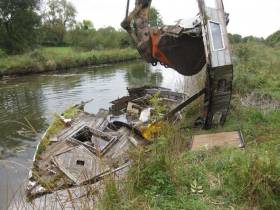Displaying items by tag: lowtown
Sunken Craft Removed From the Barrow Line of the Grand Canal
The salvage and disposal of a number of sunk and abandoned vessels from the Barrow Line of the Grand Canal at Lowtown took place on 12-13 October 2016 by Waterways Ireland.
As part of the canals clean up a number of sunken and abandoned, non permitted, vessels were targeted for removal and disposal from the canals. Every effort was made to trace owners of the vessels via the permit database, Shannon Registration number or local knowledge. No owners or interested parties were found.
Upon inspection of all vessels by the Assistant Inspector of Navigation, it was determined that none of the vessels were salvageable and were beyond economic repair. Consequently it was decided to remove and dispose of the wrecks. A company was contracted to undertake the work.
The first vessel, a steel hulk has been sunk on the Eastern bank of the Barrow Line for approximately 5 years. Accumulated debris and rubbish hindered the pump out but eventually the vessel was floated. The vessel was recovered onto the canal bank after 7 hours of work. As initial cuts with cutting equipment were made, Waterways Ireland received a request from Heritage Boat Association to pause the removal of the vessel as it potentially had heritage value. No further cutting was done and the hulk has been left on the canal bank, overturned to prevent further ingress of water, while the HBA's interest is followed up.
Removal of the other vessels went ahead as planned. Most vessels broke up as they were being towed to the Western bank for disposal. A diver in the water recovered all floating debris and heavy materials were recovered with the assistance of a digger bucket.
One vessel was pumped out and returned to its owner who was identified after a number of phone calls on 13th October.
Vessel removal was completed on 13th October with contractor returning on site on 14th October to "dress" the bank and remove any remaining debris.
Waterways Ireland requests owners of boats on the Grand Canal, Royal Canal and Barrow Navigation to ensure they have a valid permit and that the Inspector of Navigation has been provided with up to date contact details.
Lowtown's Public Moorings to Open Shortly
#lowtown – Waterways Ireland's work to redevelop the moorings and other amenities on the Grand Canal and Old Barrow Line at Lowtown, Co Kildare is nearing completion and will be opened shortly.
Waterways Ireland had already provided a new amenity block including toilets and showers at the area and has gone on to add extensive facilities for both touring boats and boats wishing to take an Extended Mooring. 350 meters of fixed timber mooring have been installed all of which have water & lighting and a proportion also have electricity.
On the Old Barrow Line and Grand Canal Main Line 100m and 80m respectively of fixed timber moorings, have been constructed with service bollards providing lighting and water.
Additionally on the Grand Canal Main Line 170m of fixed timber moorings have been constructed on the with service bollards providing electricity, lighting and water. The electricity provision is operated by smart card available from the Waterways Ireland webshop shopwaterwaysireland.org . Waterways Ireland has also constructed a dedicated parking area and bin area for boats using the long term facility.
A proportion of the moorings on the Grand Canal Main Line are being set aside for Extended Mooring Permit holders. The remainder will be for visiting boats displaying a valid Combined Mooring and Passage Permit (CMP) and following the 5 day mooring rule laid down in the Bye-laws. The balance between touring and extended moorings will be determined by the level of approved applications for Extended Mooring Permits.
The works, designed by Waterways Ireland and undertaken by LM Keating, Co Clare also included the construction of a canal overflow on the Grand Canal at Derrymullen in order to assist with the management of water levels.

New Waterways Ireland moorings on the Barrow line ready for the 2013 boating season
Application for Extended Moorings at Lowtown opened on the 4th March 2013, cost €152 for 12 months and are allocated on a first come, first served basis. Applicants need also hold a CMP (€126) and can apply using the same application form. The form can be downloaded from www.waterwaysireland.org or send out by post from Waterways Ireland Tullamore (Tel 057 9352300).
Boat owners with boats on the Grand Canal, Barrow Navigation and Royal Canal should be aware that from the 19th March the mooring bye-laws will be enforced.
More information is available from Shane Anderson, Assistant Inspector of Navigation: Tel no +353 (0)87 286 5726, Email [email protected] .






























































